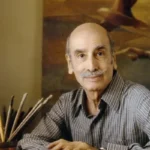"My art, a mixture of academic, impressionist and cubist texture, form and colour, acquired a distinct style in the mid ’60s. And with each step I have evolved a new experience. But if I look back, I find I have carried all the elements forward."
Jehangir Sabavala’s legendary oeuvre doesn’t quite fit into the confines of defined genres, as he seamlessly traverses between styles, melting distinct techniques within each artwork. Working primarily in oils, Sabavala created landscapes, seascapes, cityscapes, and figures with transcendental brush strokes combined with a subtle palette of colours. He often worked with geometrical elements, infusing their sharp edges with a surreal serenity. He is noted for his remarkable sense of depth, which illustrates his honed proficiency over light, colour and texture. Sabavala’s preoccupation with precision manifests through structural forms, meticulously layered with soft hues. The artist ceaselessly reinvented himself as a painter for over six decades, making a significant mark in the larger canon of Indian Art History.
Born in 1922 in Mumbai, Sabavala received a diploma in Fine Art from Sir. J.J. School of Art. He then went to Europe to study at the Heatherley School of Art, London in 1944, at Academie Andre Lhote, Paris between 1945 and 1947, at Academie Julian, Paris from 1953 to 1954, and ultimately at Academie de la Grande Chaumiere, Paris in 1957. Sabavala’s first solo exhibition was held in a hired room of the Taj Mahal Hotel in Mumbai, put up with the help of fellow artist M.F. Husain and a couple of carpenters. To the artist’s credit are over thirty solo exhibitions held across India and beyond. His last solo exhibits include 'Ricorso' at Aicon Gallery, New York, in 2009 and Sakshi Gallery, Mumbai, in 2008; and ‘Jehangir Sabavala: A Retrospective’ presented by Sakshi Gallery at the National Gallery of Modern Art, Mumbai and New Delhi, in 2005-06. Sabavala’s works have also been featured in numerous group exhibitions all over the world. Three monographs have been published on the artist by eminent art publishers including the house of Tata- McGraw-Hill and the Lalit Kala Akademi, New Delhi. ‘Colours of Absence’, a film on his life, won the National Award in 1994. Sabavala was awarded the ‘Padma Shri’ by the Government of India in 1977, and the Lalit Kala Ratna by the President of India in 2007.
Sabavala passed away in 2011.
Jehangir Sabavala’s legendary oeuvre doesn’t quite fit into the confines of defined genres, as he seamlessly traverses between styles, melting distinct techniques within each artwork. Working primarily in oils, Sabavala created landscapes, seascapes, cityscapes, and figures with transcendental brush strokes combined with a subtle palette of colours. He often worked with geometrical elements, infusing their sharp edges with a surreal serenity. He is noted for his remarkable sense of depth, which illustrates his honed proficiency over light, colour and texture. Sabavala’s preoccupation with precision manifests through structural forms, meticulously layered with soft hues. The artist ceaselessly reinvented himself as a painter for over six decades, making a significant mark in the larger canon of Indian Art History.
Born in 1922 in Mumbai, Sabavala received a diploma in Fine Art from Sir. J.J. School of Art. He then went to Europe to study at the Heatherley School of Art, London in 1944, at Academie Andre Lhote, Paris between 1945 and 1947, at Academie Julian, Paris from 1953 to 1954, and ultimately at Academie de la Grande Chaumiere, Paris in 1957. Sabavala’s first solo exhibition was held in a hired room of the Taj Mahal Hotel in Mumbai, put up with the help of fellow artist M.F. Husain and a couple of carpenters. To the artist’s credit are over thirty solo exhibitions held across India and beyond. His last solo exhibits include 'Ricorso' at Aicon Gallery, New York, in 2009 and Sakshi Gallery, Mumbai, in 2008; and ‘Jehangir Sabavala: A Retrospective’ presented by Sakshi Gallery at the National Gallery of Modern Art, Mumbai and New Delhi, in 2005-06. Sabavala’s works have also been featured in numerous group exhibitions all over the world. Three monographs have been published on the artist by eminent art publishers including the house of Tata- McGraw-Hill and the Lalit Kala Akademi, New Delhi. ‘Colours of Absence’, a film on his life, won the National Award in 1994. Sabavala was awarded the ‘Padma Shri’ by the Government of India in 1977, and the Lalit Kala Ratna by the President of India in 2007.
Sabavala passed away in 2011.

Shows
 Back
Back










